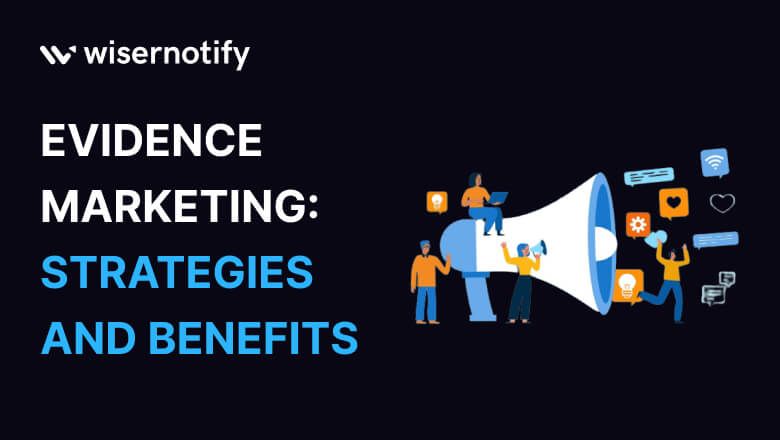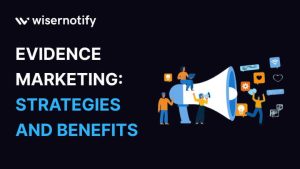You’ve heard it before: “You need to be data-driven with your marketing.”
But what does that actually mean? And more importantly, how do you make evidence-based marketing actually happen at your company?
The truth is, for a lot of businesses, data-driven marketing is still more fantasy than reality. Sure, they might track metrics like website traffic and social media engagement. But basing their entire strategy on hard evidence? Not so much.
If that sounds like your situation, don’t worry. In this guide, I’m going to break down everything you need to know about evidence based marketing.
We’ll cover:
- Exactly what evidence-based marketing is (and isn’t)
- Why an evidence-driven approach is so important these days
- How to actually implement data into your marketing process
- Examples of companies that are totally nailing evidence-based marketing
Let’s take it from the top.
Boost Conversions with Social Proof & FOMO CTAs
Try WiserNotify and build your website’s trust and credibility.
What is Evidence-Based Marketing?
Evidence-based marketing is the practice of basing ALL of your marketing decisions on data and analytics, rather than going with your gut instinct.
So instead of running campaigns because “they feel right”, you look at real-world data to figure out the messaging, channels, and assets that actually move the needle for your business.
Here’s an example:
Let’s say your e-commerce company gets a ton of traffic from Instagram. You might assume that investing more resources into IG is a no-brainer, right?
But once you dig into your analytics, you realize that Instagram traffic has an abnormally high bounce rate and low conversion rate.
On the other hand, Google Search traffic makes up a smaller percentage of your total traffic… but people coming from Google stick around longer and are way more likely to buy.
An old-school, gut-driven marketer may have blindly put more into Instagram based on traffic numbers alone.
But an evidence-based approach shows that doubling down on Google SEO is the smarter move for driving revenue, even if it brings less top-line traffic.
Why Evidence-Based Marketing is So Important Today
You might be thinking: “OK, basing decisions on data makes sense. But couldn’t we just say that’s always been good marketing 101?”
True, considering evidence before making big decisions is just basic common sense.
But in 2025, evidence based marketing isn’t just a nice-to-have. It’s an absolute must for companies that want to survive and thrive. Here’s why:
- Customers Demand Relevant Experiences: Today’s buyers are bombarded with marketing messages from every angle. If your website, ads and content don’t feel highly targeted and relevant to their needs, they’ll just ignore you.
- Tough Competition: Every industry is more competitive than ever. While attention spans are lower, the number of competitors fighting for those limited attention minutes continues to grow. You need data to separate the winners from the “also-rans.”
- Skyrocketing Costs: Whether you’re investing in content marketing, today’s rates are through the roof. A data-driven strategy is a must to ensure you’re not wasting money on stuff that doesn’t work.
- Fast Iteration Cycles: Consumer trends and behaviors seem to change on a weekly or monthly basis in 2025. Without fresh data insights constantly guiding your strategy, you’ll quickly become irrelevant.
The bottom line? Evidence based marketing is no longer a luxury. In 2025, it’s a requirement for any business that wants to maximize ROI and move the needle.
Let’s look at how to get started.
How to Implement an Evidence-Based Marketing Strategy
Alright, so hopefully I’ve convinced you that going all-in on evidence based marketing isn’t just a nice idea… it’s absolutely essential to succeed in today’s cutthroat marketplace.
But how do you actually do it? What are the concrete steps for basing your decisions on hard data rather than hunches?
Well, there are 4 key things you need:
- Integrate Data Sources Into a Centralized Analytics Platform
- Perform Consistent Testing and Optimization
- Interpret Your Analytics With Context
- Institutionalize a Data-Driven Culture
Let’s break each of those down.
1. Integrate Data Sources Into a Centralized Analytics Platform
Integrate Data Sources Into a Centralized Analytics Platform The first step is making sure that all of your key data sources are integrated into a single unified analytics platform.
You’ll want data flowing in from:
- Your website (Google Analytics, heatmaps etc.)
- Marketing channels (ad platforms, email software)
- CRM and sales data
- Customer support and service data
- Social media analytics
- Any other platform that generates marketing/customer data
With all of this information living in one place, you can start to look at the big picture. How are your campaigns impacting behavior across multiple channels? Where are people dropping off in your funnel? All of these insights will guide your optimizations.
2. Perform Consistent Testing and Optimization
Perform Consistent Testing and Optimization Once your analytics house is in order, the next step is to make testing and optimization part of your team’s regular routine.
For example, you might:
- Run frequent A/B tests on landing pages and website UX
- Test different Facebook ad creative and copy
- Try out new segmentation for your email campaigns
- Experiment with messaging and positioning for your content
The goal is to never just “set it and forget it.” Aspects of your strategy should constantly be tested and tweaked based on what’s working (and not working) according to the data.
Build trust & FOMO
Highlight real-time activities like reviews, sales & sign-ups.
3. Interpret Your Analytics With Context
Interpret Your Analytics With Context Here’s a key mistake teams make when first trying to become “data-driven”:
They look at the numbers in silos and jump to conclusions, completely missing important context.
For example: Let’s say your latest blog post got 50% less traffic than typical. Bummer, right? Not necessarily. If that post was meant to be an ultra-targeted piece of content that attracted lots of high-intent traffic, a 50% traffic drop might actually be a good thing if it resulted in better qualified visitors.
The point is: You can’t look at numbers on their own. You have to understand the greater context and full picture of your strategy before making decisions based on data.
So make it a habit to dig beyond the surface-level metrics. Seek to understand user behavior and buying patterns. Talk to your customers to add qualitative insights to your data. And use all of this context to enrich your analytics.
4. Institutionalize a Data-Driven Culture
Institutionalize a Data-Driven Culture Last but not least, you need to systematize evidence based marketing into your company culture and workflows.
If data-driven decision making is just an informal process, it’ll peter out over time. You need to institutionalize it into your operations.
For example:
- Build data review meetings into your regular calendar
- Align KPIs and goals across marketing and other teams
- Create processes for surfacing insights and making recommendations based on data
- Invest in training and certifications to upskill your team on analytics and statistics
- Compensate people based on measurable results, not vanity metrics
The more you can build data into the way you hire and operate as a business, the more success you’ll have with evidence based marketing.
Examples of Evidence-Based Marketing in Action
Evidence based marketing shouldn’t feel like a pie-in-the-sky concept. Plenty of companies are already doing it really well.
To give you a taste of what it looks like in practice, here are a few quick case studies:
Hubspot: Data is baked into everything Hubspot does. For example, their famous website makes a “smart” content decision for every visitor based on factors like location, device, traffic source and behavior. All powered by their analytics collecting insights on what messaging and experiences work best.
Chubbies: This men’s apparel brand puts a huge priority on data-driven merchandising. They carefully track sales data to determine the ideal product mix and inventory levels. By letting hard numbers guide decisions like new clothing line launches, sizing, and inventory distribution across warehouses, they’ve been able to rapidly scale while keeping costs in check.
Mint Mobile: The maverick mobile carrier wants “decision over dogma” according to their head of marketing. They embrace a “invest, measure, pivot” approach where they rapidly test new channel and creative strategies—then double down on whatever the data shows is delivering the best ROI. It’s a big reason why they’ve achieved such explosive growth.
Zappos: You probably know Zappos for their legendary customer service and company culture. But what you may not realize is that their prioritization of evidence-based marketing has been a huge driver of their success. From A/B testing every aspect of their website and marketing campaigns, to poring over qualitative customer feedback, they let data and customer insights steer all of their biggest decisions.
As those examples show, plenty of top brands are already walking the walk and using data to drive their marketing strategies. But there’s still a long way to go for many companies.
Build trust & FOMO
Highlight real-time activities like reviews, sales & sign-ups.
Wrap up
Are You Ready to Go All-In on Evidence-Based Marketing?
Does leveling up to an insights-driven marketing strategy require an investment of time, money, and effort? Absolutely.
But what’s the alternative? Making decisions based on hunches and going with your gut is a recipe for wasted money and stagnation. Your competition will eventually eat you for lunch.
The good news is that if you start implementing the tactics and principles from this guide, you’ll be well on your way to building a truly data-driven marketing engine—one that generates a steady stream of evidence to guide your spending and strategy in the right direction.
No guesswork is required.
So what are you waiting for? Let’s dive into your analytics and start separating fact from fiction in your marketing. Your bottom line will thank you.
Build trust & FOMO
Highlight real-time activities like reviews, sales & sign-ups.








